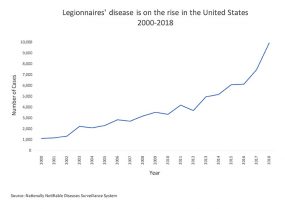For Media
Listed below are answers to common background questions that reporters have about legionellosis. Contact CDC’s Media Relations office with additional questions.
Questions and Answers
Q: Is legionellosis (Legionnaires’ disease and Pontiac fever) reportable?
A: Yes, legionellosis is a nationally notifiable disease. Lab-confirmed cases of legionellosis should be reported to state health departments, who are to notify CDC. The state, territorial, or local health department where a patient lives or an outbreak is occurring is the best source of information about specific cases or situations. However, health departments usually release very limited information about cases in order to protect the privacy of those affected.
Q: Can CDC confirm if there are Legionnaires’ disease cases in my state?
A: Your local or state health department has the most up-to-date information about Legionnaires’ disease cases in your state. Unless the health department has contacted CDC, we are unlikely to be immediately aware of local cases. However, we can answer questions about Legionnaires’ disease in general.
Each week, health departments report cases of Legionnaires’ disease to CDC. Learn more about reported cases of Legionnaires’ disease.
Q: When does CDC get involved in responding to outbreaks of Legionnaires’ disease or Pontiac fever?

In the United States, the rate of reported cases of Legionnaires’ disease has grown by nearly nine times since 2000.
It is unclear whether this increase represents artifact (due to increased awareness and testing), increased susceptibility of the population, increased Legionella in the environment, or some combination of factors.
A: State or territorial public health officials typically invite CDC to assist with an investigation when they need additional expertise, capacity, or resources. For information about a current outbreak, contact the state, territorial, or local health department where the outbreak is occurring.
Q: How common is Legionnaires’ disease?
A: Health departments reported nearly 10,000 cases of Legionnaires’ disease in the United States in 2018. However, because Legionnaires’ disease is likely underdiagnosed, this number may underestimate the true incidence. A recent study estimated that the true number of Legionnaires’ disease cases may be 1.8–2.7 times higher than what is reported.
Learn more about Legionnaires’ disease and read the latest surveillance report.
Q: Is Legionnaires’ disease on the rise?
A: In general, the number of cases reported to CDC has been on the rise since 2000. This may reflect a true increase in the frequency of disease due to a number of factors (e.g., older U.S. population, more at-risk people, aging plumbing infrastructure, climate). It may also be in part a result of increased use of diagnostic testing or better reporting.
Q: Where does Legionnaires’ disease occur most often in the United States?
A: The rate of reported Legionnaires’ disease cases tends to be higher in the Mid-Atlantic and Northeastern Central regions than in the South and West. Researchers are not certain why that is, but it is likely related to a combination of factors.